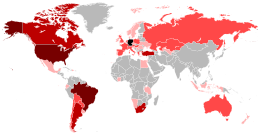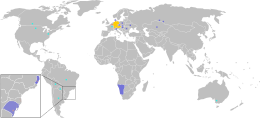
Back Агерман бызшәа Abkhazian Bahsa Jeureuman ACE Германыбзэ ADY Duits Afrikaans Deutsche Sprache ALS ጀርመንኛ Amharic Idioma alemán AN Þēodsc sprǣc ANG जर्मन भाषा ANP اللغة الألمانية Arabic

German (Deutsch, pronounced [dɔʏtʃ] ⓘ)[10] is a West Germanic language in the Indo-European language family, mainly spoken in Western and Central Europe. It is the most spoken native language within the European Union. It is the most widely spoken and official (or co-official) language in Germany, Austria, Switzerland, Liechtenstein, and the Italian autonomous province of South Tyrol. It is also an official language of Luxembourg, Belgium and the Italian autonomous region of Friuli-Venezia Giulia, as well as a recognized national language in Namibia. There are also notable German-speaking communities in France (Alsace), the Czech Republic (North Bohemia), Poland (Upper Silesia), Slovakia (Košice Region, Spiš, and Hauerland), Denmark (North Schleswig), Romania and Hungary (Sopron). Overseas, sizeable communities of German-speakers are found in Brazil (Blumenau and Pomerode), South Africa (Kroondal), Namibia, among others, some communities have decidedly Austrian German or Swiss German characters (e.g. Pozuzo, Peru).
German is one of the major languages of the world. German is the second-most widely spoken Germanic language, after English, both as a first and as a second language. German is also widely taught as a foreign language, especially in continental Europe (where it is the third most taught foreign language after English and French), and in the United States. Overall, German is the fourth most commonly learned second language,[11] and the third most commonly learned second language in the United States in K-12 education.[12] The language has been influential in the fields of philosophy, theology, science, and technology. It is the second most commonly used language in science[13] and the third most widely used language on websites.[13][14] The German-speaking countries are ranked fifth in terms of annual publication of new books, with one-tenth of all books (including e-books) in the world being published in German.[15]
German is most closely related to other West Germanic languages, namely Afrikaans, Dutch, English, the Frisian languages, and Scots. It also contains close similarities in vocabulary to some languages in the North Germanic group, such as Danish, Norwegian, and Swedish. Modern German gradually developed from Old High German, which in turn developed from Proto-Germanic during the Early Middle Ages.
German is an inflected language, with four cases for nouns, pronouns, and adjectives (nominative, accusative, genitive, dative); three genders (masculine, feminine, neuter) and two numbers (singular, plural). It has strong and weak verbs. The majority of its vocabulary derives from the ancient Germanic branch of the Indo-European language family, while a smaller share is partly derived from Latin and Greek, along with fewer words borrowed from French and Modern English. English, however, is the main source of more recent loanwords.
German is a pluricentric language; the three standardized variants are German, Austrian, and Swiss Standard German. Standard German is sometimes called High German, which refers to its regional origin. German is also notable for its broad spectrum of dialects, with many varieties existing in Europe and other parts of the world. Some of these non-standard varieties have become recognized and protected by regional or national governments.[16]
Since 2004, heads of state of the German-speaking countries have met every year,[17] and the Council for German Orthography has been the main international body regulating German orthography.
- ^ Thomas Marten, Fritz Joachim Sauer (Hrsg.): Länderkunde Deutschland, Österreich und Schweiz (mit Liechtenstein) im Querschnitt. Inform-Verlag, Berlin 2005, ISBN 3-9805843-1-3, S. 7.
- ^ Cite error: The named reference
eurobarometerwas invoked but never defined (see the help page). - ^ "Moses Mendelssohn's Be'ur: Translating the Torah in the Age of Enlightenment – TheTorah.com". www.thetorah.com. Archived from the original on 29 January 2024. Retrieved 10 August 2023.
- ^ "Sefer Netivot ha-shalom: ṿe-hu ḥibur kolel ḥamishat ḥumshe ha-torah ʻim tiḳun sofrim ṿe-targum ashkenazi u-veʾur. - 1783. Translated from the Hebrew into German by Moses Mendelssohn. Berlin : Gedruckt bey George Friedrich Starcke". digipres.cjh.org. Archived from the original on 10 August 2023. Retrieved 10 August 2023.
- ^ "המאסף ha-Me'asef. 6644-5571 [1783-1811] [Newspaper in German printed in Hebrew characters]. Königsberg, Prussia". Archived from the original on 10 August 2023. Retrieved 10 August 2023.
- ^ "YIVO | Dostrzegacz Nadwiślański - / Der Beobakhter an der Vayksel. 1823–1824. Warsaw". yivoencyclopedia.org. Archived from the original on 28 August 2023. Retrieved 10 August 2023.
- ^ "Birgit Klein. 1998. Levi von Bonn alias Löb Kraus und die Juden im Alten Reich. Auf den Spuren eines Verrats mit weitreichenden Folgen, p. 200" (PDF). Archived (PDF) from the original on 10 August 2023. Retrieved 10 August 2023.
- ^ "Lista de línguas cooficiais em municípios brasileiros". ipol.org.br. IPOL. Archived from the original on 12 December 2021. Retrieved 28 October 2023.
- ^ a b Goossens 1983, p. 27.
- ^ "Deutsch". Digitales Wörterbuch der deutschen Sprache (in German). 31 October 2022. Archived from the original on 24 November 2023. Retrieved 27 March 2024.
- ^ "German is world's fourth most popular language". The Local. 15 April 2015. Retrieved 3 September 2024.
- ^ "Foreign Language Enrollments in K–12 Public Schools" (PDF). American Council on the Teaching of Foreign Languages (ACTFL). February 2011. Archived from the original (PDF) on 17 August 2014. Retrieved 17 October 2015.
- ^ a b Abdumannonovna, Akhmedova Dilnoza (13 February 2022). "GERMAN AS THE LANGUAGE OF SCIENCE: PROBLEMS AND PERSPECTIVES". World Bulletin of Social Sciences. 7: 22–24. Retrieved 2 September 2024.
- ^ "Usage statistics of content languages for websites". w3techs.com. 3 September 2024. Retrieved 3 September 2024.
- ^ Lobachev, Sergey (17 December 2008). "Top languages in global information production". Partnership: The Canadian Journal of Library and Information Practice and Research. 3 (2). doi:10.21083/partnership.v3i2.826.
- ^ Chase, Jefferson (25 September 2016). "Preserving endangered German dialects". Deutsche Welle. Retrieved 2 September 2024.
- ^ Land, Lëtzebuerger (2 September 2016). "Beim Deutschen Bund in Eupen". Lëtzebuerger Land. Archived from the original on 21 December 2022. Retrieved 11 December 2023.
Cite error: There are <ref group=note> tags on this page, but the references will not show without a {{reflist|group=note}} template (see the help page).

